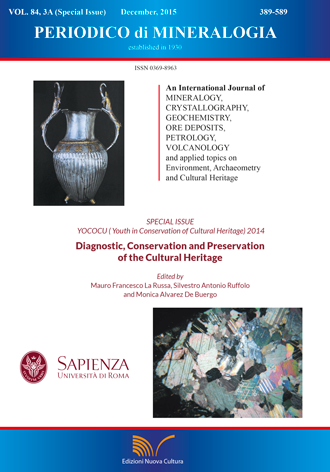Hyperspectral imaging-based approach for the in-situ characterization of ancient Roman wall paintings
DOI:
https://doi.org/10.2451/2015PM0021Keywords:
wall paintings, hyperspectral imaging, Raman spectroscopy, reflectance spectroscopy, chemometric methods, optical microscopy.Abstract
A diagnostic study was recently carried out on fragments of wall paintings belonging to the decorations of an old Roman residential villa of the Ager Gabinus, in the locality Pratolungo (Rome, Italy). The study was organized in two stages. A first stage, in which small splinters of these painted specimens were embedded in resin to obtain polished and thin cross-sections to study by optical microscopy and a second phase, in which the specimens were analyzed by Raman Spectrometry and HyperSpectral Imaging (HSI). The results obtained by classical methods (i.e. optical microscopy), were compared with those resulting from non-destructive investigation such as, Raman spectroscopy and HSI based techniques. The attention was particularly addressed to the utilization of HSI in the SWIR range (1000-2500 nm), being this techniques potentially used directly in situ without any physical sampling/removal of the specimen of interest. The collected hyperspectral data (i.e. images) were processed applying chemometric methods. For its intrinsic characteristics, the utilization of HSI as a diagnostic tool in the field of cultural heritage is of great interest and it presents high potentialities, being this analysis intrinsically non-destructive, non-invasive and in principle applicable in any site. Furthermore, the possibility to couple hyperspectral data with chemometric techniques allows getting not only qualitative but also quantitative information on the nature and the physical-chemical attributes and characteristics of the investigated materials. Following this strategy, it is thus possible to obtain information comparable with those commonly acquired by optical microscopy, allowing also the identification of pigments and the constituent materials directly in situ.


